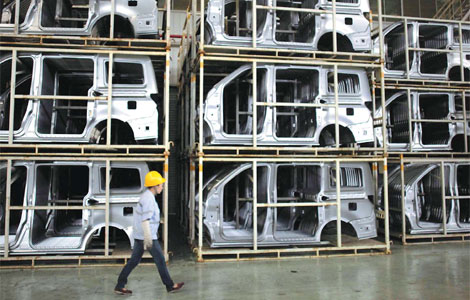High-end manufacturing holds the key
Updated: 2013-06-07 07:32
By Zheng Yangpeng (China Daily)
|
|||||||||||
"Like every other Chinese, they also want to own a house. But in Suzhou, that dream is almost impossible to realize. When they realize this, they are disappointed and often leave for a higher-paying job in other cities."
Apprehensions are also growing in industry circles that the floating and shrinking labor force would soon become a grave threat to Chinese companies as they look to make rapid strides in global competitiveness.
"A foreign diplomat recently told me that Chinese products are facing the same challenges that Japanese and South Korean products faced earlier from China. The only difference is that the competition is now from other Southeast Asian nations," said Zhou Shijian, a senior trade expert at Tsinghua University.
The yuan's appreciation against the US dollar has also been bad for the competitiveness of Chinese products, Zhou said.
"According to the research findings of a Japanese nonprofit trade institute, the average monthly wages for a worker in Guangzhou is 1,850 yuan ($295), while it is 752 yuan in Vietnam. With such a huge gap, China may find it difficult to compete with other Southeast Asian nations in low-end products," Zhou said.
The 2013 Global Manufacturing Competitiveness Index, however, paints a totally different picture. Most of the 550 chief executive officers and senior leaders of global manufacturing companies, who participated in the survey, admitted that China remains the top destination for manufacturing, and will retain its top ranking for the next five years.
Related Stories
China unveils top machinery, auto manufacturers 2013-05-31 08:58
China's manufacturing slows to 7-month low: HSBC 2013-05-23 13:34
Shifting manufacturing footprint inspires migrant workers' homecoming 2013-05-29 10:06
China manufacturing shrinks in May 2013-05-24 09:50
Nanjing to get $100m manufacturing center 2013-04-16 15:09
CSR starts building manufacturing center in Malaysia 2013-04-10 13:39
Today's Top News
EU wine producers surprised by investigation
China to protect investors' interests: President Xi
DPRK proposes meeting with ROK on Sunday
Xi arrives in California for summit with Obama
China's economy might be No 1 in 2030
Probe of EU wine 'not retaliation'
355,000 parents have lost only children
Russian President Putin, wife announce divorce
Hot Topics
Lunar probe , China growth forecasts, Emission rules get tougher, China seen through 'colored lens', International board,
Editor's Picks

|

|

|

|

|

|





